GSoC-WesnothWhiteboard Gabba
| This page is related to Summer of Code 2010 |
| See the list of Summer of Code 2010 Ideas |
| This is a Summer of Code 2010 student page |
Contents
- 1 Description
- 2 IRC
- 3 About Me
- 4 History
- 5 Credits
- 6 The Problem
- 7 The Project
- 7.1 Overview
- 7.2 Interface
- 7.2.1 A little use case
- 7.2.2 Features
- 7.2.3 Options
- 7.2.4 Summary of commands
- 7.2.5 Mockups for various interface elements
- 7.3 Engine
- 7.4 Clean up
- 7.5 Gameplay considerations
- 7.6 Optional/Future developments
- 8 Calendar
Description
Gabba - Interface Streamlining and Planning System
I intend to rework the current Wesnoth interface by introducing a planning system that will allow you to give orders and modify them before executing them as a "real action".
Side benefits include:
- allowing you and your allies to visually plan moves on the map together
- replacing "delay shroud updates" by a more elegant system
- finally making wml "sighted" events work properly
Updated 04/06/2010
IRC
gabba
About Me
See User:Gabba
History
To put things in context, this idea was already discussed in embryonic form
- here: http://www.wesnoth.org/forum/viewtopic.php?f=15&t=26324
- and then here: http://www.wesnoth.org/forum/viewtopic.php?f=12&t=29102&start=0
- and again here: https://mail.gna.org/public/wesnoth-dev/2010-03/msg00001.html
- and finally here: GSoC-ShareUndoableMovesWithAllies_Gabba
before it ended up as this formal GSoC proposal.
Credits
- Boucman for introducing the idea of setting gotos when it's not your turn, and his thorough review of the proposal.
- Crab_ for the overall concept and the backend mechanisms, as well as many details I would not have thought of.
- Mordante for his review and comments.
- Noy for analysing in depth the gameplay implications.
The Problem
Waiting tedium and difficult allied planning
Currently when playing a coop game (either RPG or more standard multiplayer campaign), there are several things that really irk me when it's not my turn:
- You wait a long time before seeing anything happening (unless your opponents are playing without delay shroud updates).
- When your ally who's taking his turn finally attacks an enemy or makes another non-undoable move, you have to sit through a delayed replay of his moves. If he already finished his turn, your ally has to wait while you watch this.
- After a few undoable moves by either allied player, communication is completely out of sync. If you tell your ally, "look, I'm encircling his leader", he has no clue what you're talking about: he doesn't see what you're doing. If your ally asks you "should I move my white mage here to heal you units next turn", you 1) have no clue about which hex "here" is supposed to mean 2) even if you did, you can't adequately counsel him, since you don't see how he positioned his other units.
For this last point, you can of course place labels all over the place, but this project intends to provide a much more natural way to communicate.
Conflicts between undo and various events
Undo and delay shroud updates are very useful, but several game features conflict with them. You could have 10 temporary moves planned, just to see what your ZOC would look like, but the first of any of these events will makes you lose any undo possibility:
- Triggering an ambush
- Triggering an WML event ("sighted" in particular poses problems)
- Attacking a unit
One of the goals of this project is to remove conflicts between planning moves, and this kind of event.
Annoying gotos
Gotos (i.e. multi-turn moves) can be useful, but are also annoying since they are executed automatically at the beginning of your turn, and there's no visual display to show you at a glance which units have gotos set. You have no way to modify them outside of your turn either, to react to an unexpected turn of events.
The Project
Overview
My project directly addresses the problems described above:
Waiting tedium and difficult allied planning (solution)
- Instead of waiting, you'll be able to plan moves (and recruits, attacks, etc) while the others are playing.
- If you have allies, a whole new dimension opens:
- You'll see the moves of your currently playing ally as he plans them, and therefore will be able to comment on them before he commits them
- Even better, he'll be able to see any moves you have planned for your turn, so you can finally coordinate that white mage placement or that attack correctly.
Conflicts between undo and various events (solution)
You'll be able to plan as many moves as you want, but unlike the current "undoable moves", they won't become "real" until you decide to:
- Simply planning a moves triggers nothing. Shroud updates, WML events, ambushes and the like won't have the possibility of happening until you decide to execute a move.
- When you commit a move and it does trigger an ambush, shroud update or WML event, your other planned moves will stay modifiable. The game will simply show you which of your remaining planned moves have become invalid because of the changing situation, so you can modify or replace them at your leisure.
- Unlike undoable moves which must be undone in order, planned moves can be undone in any order, and commited individually in any order.
Annoying gotos (solution)
If you don't want to rely on self-executing gotos, you won't have to. You'll be able to plan multi-turn moves, they'll always be visible on the map (and to your allies), and the part that corresponds to the current turn will execute only when you decide to.
Interface
A little use case
Let's say it's the beginning of your turn, and you have planning mode turned on. You select one of your elven archers, move your mouse around, and click a destination to move it to. Instead of your unit moving immediately, you'll see an arrow-terminated line showing the path your unit will take to get there, and a "ghost" (i.e. semi-transparent) form of the archer at the destination position. You repeat this with an elven fighter and a scout, and all three paths now show on the map.
Now, since you're playing as a team of two, you're not sure that the moves you picked will really benefit the team. You chat with your ally, and ask him "should I send my scout this way?". Fortunately, he sees on his screen the same arrows as you, and therefore the move you plan for the scout. "Sure", he answers. With renewed confidence, you hover the mouse over your elven scout and press 'E' to execute the move. The unit now really moves, and the arrow disappears.
Before committing the two other moves, you want some assurance that you'll have backup, since the orcs are charging at you across the plain. You ask your ally: "Can you move your white mage behind my archer and fighter?", and he agrees to do it. Even though it's not his turn, he selects his white mage and picks a destination for him, right next to your two units. You both see on your screens the path and the destination of the mage (on your screen his arrow shows in his team color); you now feel safer and decide to commit all moves. You select "Execute All" from the context menu, and the game starts executing your remaining planned actions in the order you defined them.
The archer starts its move, but unfortunately it gets ambushed mid-way by a sneaky orcish assassin (you are playing the "Ambushing Assassin Era" :P). Since a special event happened, the game stops executing your moves. You decide to change the planned move of the fighter and attack the orcish assassin; since it's your last unit and you don't really need to plan the move before executing it, you shift-click to attack the orc, and the attack happens immediately. When his turn comes (or even before), your ally will probably also change the destination of his white mage.
Without depicting the scene frame by frame, the mockup below shows a tentative look for the interface elements necessary to realize this use case:
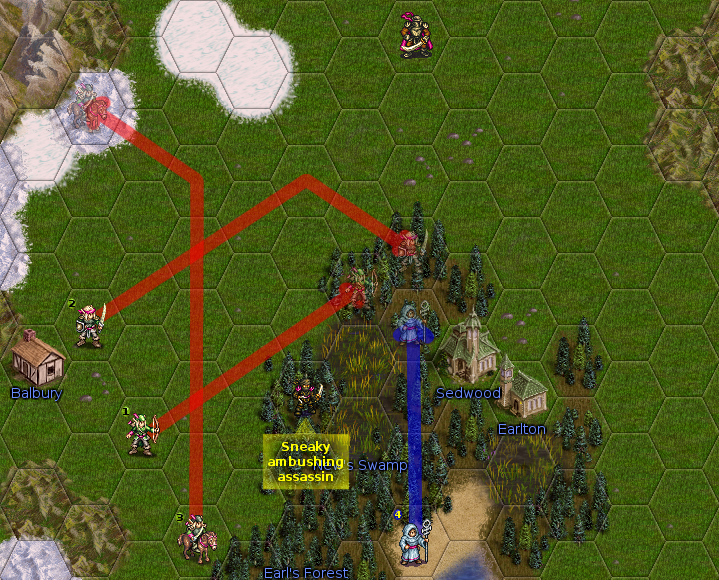
(Yes, I know that orcish assassins usually don't have ambush, but this one took courses from a renegade Elvish Ranger. Understood?)
- Red arrows are planned moves for the current player, the blue arrow is a move planned by his ally.
- Also notice the numbering, that corresponds to the order of programmed moves. The white mage should actually bear the number 1, if moving it is the first planned move that his owner set up. (See Variants and experiments on the numbering system: various ways of displaying those numbers are being considered.)
Features
These are the features planned for the Wesnoth Planning System interface.
Disclaimer: all artistic details in this proposal, such as the display of arrows, numbers and the like, are subject to change.
Planning various actions
The player will be able to plan visually on the map all his actions (moves, attacks, recruits/recalls) before "making them real", i.e. commiting them. He will also see on his map all planned actions from his allies who have shared them. Filtering those actions per-ally will be possible, to minimize map clutter. The display for those actions will be identical to his own, except they'll be clearly identified by the originating player's team color.
Moves and attacks
When the player selects a unit with movement points remaining, he'll see the usual thing as he moves his mouse, i.e. footsteps and the attack indicator to show attack possibilities. When he clicks to order an attack or a move, it won't be executed right away, but rather an arrow will be draw from the units current to its future position, and a "ghost" form of the unit will be drawn at the destination. If the action is an attack, the action indicator will remain to show the future attack.
With several attacks planned, the display would look like this:
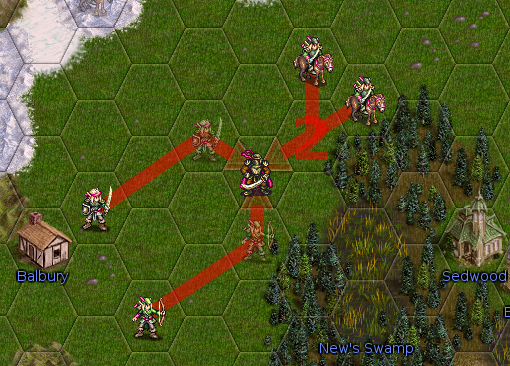
If a move will take several turns to execute, this will be displayed on the arrow in a similar manner than the current footsteps.
This image also shows a solution to display multiple moves/attacks planned for the same hex. Here: the two scouts that want to attack the orcish grunt from the same spot. We can't prevent the player from doing that, since he might have perfectly valid reasons to do so, such as repeatedly attacking a paladin with a horde of walking corpses from the only available hex.
Recruit/Recall
A "ghost" of the soon-to-be-recruited/recalled unit will appear in the hex; various visual clues are being considered to indicate the planned move status and avoid confusion with an ambushing unit.
- Do we visually decrement the player's gold (without touching the backend value) when a planned recruit is added? It looks like a good idea, so he can count up how many units he can afford before confirming the recruits/recalls.
Validation and Conflicts
The game will check all actions for validity whenever they are planned. They will also be re-checked for this after any modification to the planned moves, or after committing a move (which might trigger an ambush or a game-altering WML event). Two kind of conflicts can be detected by this validity check:
- Action Conflict ("soft conflict"): Conflict between two planned actions: any planned action which targets the same location as another. All actions displayed on screen will be checked for this, including those coming from other players. The game will let you plan voluntarily this kind of conflicting action, but will add a visual warning.
- example: the two Elvish Scouts planning to attack the Grunt from the same hex, in the image from the "little use case" section above, should both receive a conflict marker.
- Gamestate conflict ("hard conflict"): Conflict between a planned action and the game state: this would be a planned action that tries to do an impossible move, such as moving into a cave wall. You won't be able to define those voluntarily, but some actions might end up in that state because of a WML event. These conflicts will have a stronger visual warning.
With both kinds of conflicts, the player will keep the ability to delete the planned action or define another in its place.
Order of actions and Committing
Ordering of actions
Planned actions will receive a sequence number as they are added. First action get number 1, second action gets number 2, and so on. You can see some mockups of various ways of displaying those numbers in the mockups section. Each player's units will be numbered separately.
The sequence number is important for when the player would like to commit his planned actions without having to hover over individual units.
Commiting moves
Whenever the player is satisfied with one of his planned action, and this action does not have a gamestate conflict, he can individually commit it by either accessing the unit's context menu and selecting "commit", or simply hovering his mouse over it/selecting it and pressing 'e' (for "Execute", which will probably be how the user knows the command, rather than "Commit" that sounds good for svn/git users).
If no unit is selected or hovered over, then the first action in the planned move queue (the one numbered '1' on screen) will be commited.
A "fast-commit", "fast-forward" or Execute All command will be added, so that a bunch of trivial actions can be commited quickly. This command has only one goal: transform your planned moves into real moves nearly instantly. Therefore, with this command:
- The moves and recruits won't be animated, only combat will be.
- If there is shroud and you have the "stop when enemy sighted" option activated, any enemy sightings will be ignored nevertheless: this behavior is similar to what happens when you disable "delay shroud updates" after having done a bunch of undoable moves.
Committing a move means the "real" action is executed as usual in Wesnoth, and remaining planned actions get validated. Note that you do not lose your other planned actions.
- The planned action is usually deleted at this point, except if it was a multi-turn move/move-attack; in this case only the part of the path that was executed on this turn gets removed.
Re-ordering
The player will be able to change the ordering of his planned actions.
- The simplest way will be to cancel the action and to issue a new one, in which case the new order will be added at the end of the queue.
- I will also provide two commands, "bump up" and "bump down", that move the selected or hovered unit one step up or down in the action queue. Those will need shortcut keys (tentatively 'z' and 'x'), as well as menu elements.
Canceling planned actions
Canceling planned actions will be per-unit (unlike the old undo stack that forces you to undo things in order). By selecting "cancel" from the context menu of a unit or hitting 'C' while it's selected, you'll clear the planned action from that unit.
- move/attack: the ghost form, arrow and attack indicator just disappear
- recruit: the "planned recruit" ghost unit will disappear.
(Controversial) However, once a move is commited, there will be no way of undoing it.
You will also be able to cancel the planned action that was last defined if you issue the "cancel" command, without any unit selected. (This will somewhat mimic the current undo behavior, for players who prefer working that way.)
ZOC display
"Show enemy moves" will now be calculated taking into account planned unit positions, instead of real unit positions. However you'll be able to hold the tab key to see the "old" display, which takes into account only commited actions.
Planning actions when it's not your turn
The planning system will be available to plan moves, recruits and attacks when it's not your turn. If you have allies, they will see your plans if you have shared them. Design choices will need to be made in the following areas:
- Do we enable planning mode by default when it's not your turn, and then non-planning mode when your turn starts? If so, a proeminent visual reminder of which mode we're in will be needed to avoid confusing players.
- How do we deal with the "track moves" option? It should at least be impossible to set or modify a planned move when the camera has been stolen by the "track moves" feature, otherwise you'll end up very frustrated.
- A solution to both points above could be to always disable planning mode by default (but unfortunately it might prevent people from even knowing the system exists), and disable move tracking whenever planning mode is on, even temporarily such as when you're holding shift to define planned actions.
- If move tracking is disabled, adding some visual warning that something is going on outside of your sight while you're planning moves would be useful.
Options
- I will provide a dialog or menu to control who you share your planned moves to, and whose planned moves you display on your map. If the new alliance system GSoC project is implemented, these options can be integrated to the fine-grained ally controls.
- A "Toggle Planning Mode" option will be provided to invert the behavior of shift-clicking; in planning mode shift-clicking does the real action directly; in normal mode shift-clicking will rather do the planning.
Summary of commands
(Subject to change)
| Command | Shortcut key |
|---|---|
| Commit/Execute | E |
| Fast Commit/Execute All | Shift+E |
| Cancel | C |
| Direct action (planning mode) / Planned action (normal mode) | Shift+Click |
| Toggle planning mode (invert shift-click behavior) | Caps Lock |
| Bump action up and down in queue | X, Z |
| Toggle ZOC display | Tab |
Mockups for various interface elements
Highlight planned path on select or mouseover
A lot of planned paths overlaying each other would quickly get confusing, if you don't have a mean of telling which belongs to which unit. Paths will be highlighted whenever you hover over them or their unit; if a unit is selected its path will always be highlighted.
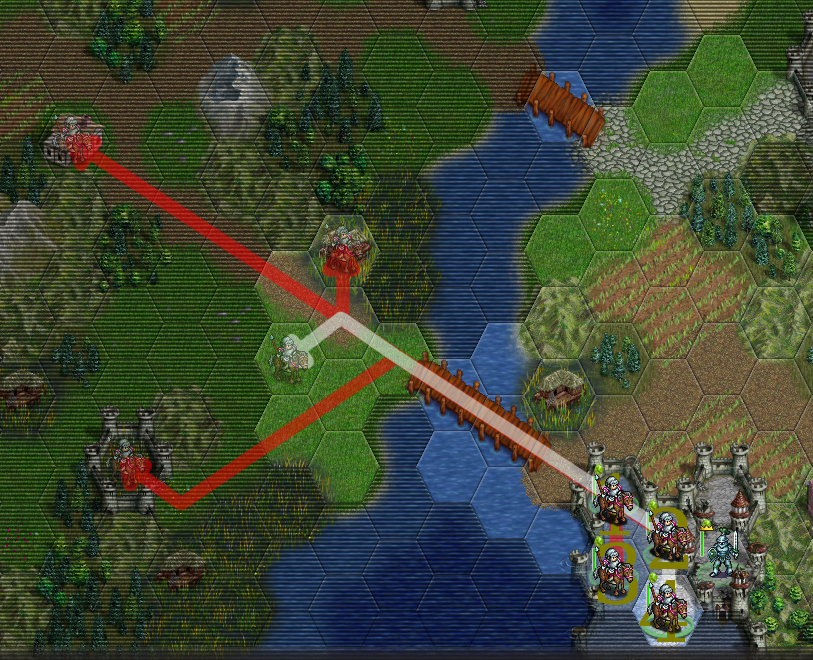
Variants and experiments on the numbering system
The "status-ball" display (cute but would pose problems for double and triple digits, and may conflict with the crown symbol):

The "overlay" display:
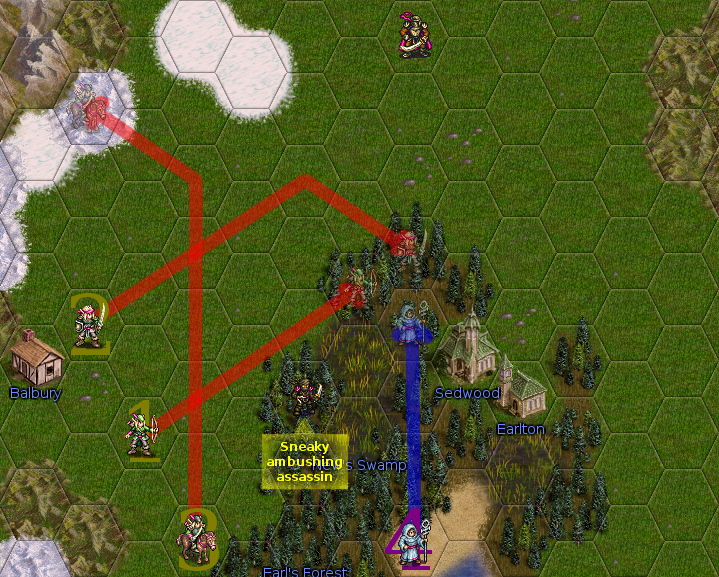
The double/triple digits "overlay" display of number seems to work ok (three-digit might need to be placed in upper-half of hex to avoid completely hiding middle digit),
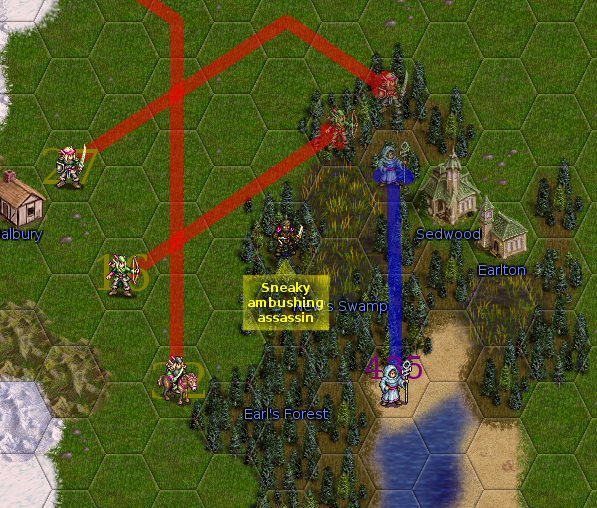
especially with brief flashing of the number on top of a unit when this unit is hovered over or selected.
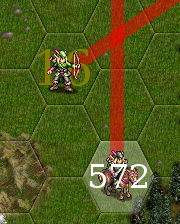
Alternative "side" display: simply show the number next to units. Less disruptive visually maybe?
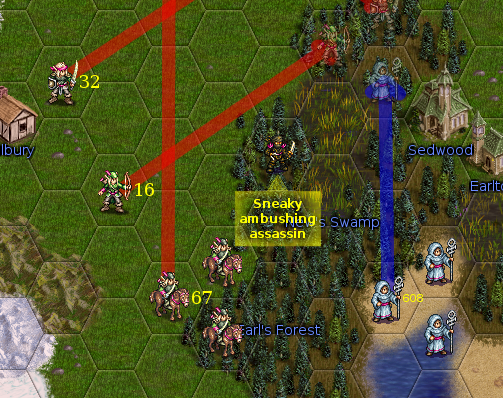
Engine
Current state of the game engine
The game state is currently synced between clients through the use of replays. As actions (recruits, moves, attacks, etc.) are executed on the current client (i.e., the client of the player who's playing his turn now), the local replay gets augmented with corresponding commands. Those commands are are stored as WML config objects, and have an undo attribute that indicates if they can still be undone, and a sent attribute that indicates if they have been synced over the network.
Periodically, the current client calls turn_info::send_data(). Through a chain of calls, this function locates non-undoable, non-sent commands (with replay::get_data_range()), and transmits them over the network (network::send_data()) after having placed them in a config object under a [turn] tag.
On the receiving end (i.e. all other clients), replay info is detected in turn_info::process_network_data(), and is eventually processed in do_replay_handle(), which actually replays the actions on the remote clients.
Changes to the game engine
For this project, I want to completely get rid of the concept of an "undoable action".
Instead, a vector of a new kind of object called planned_action will be maintained on each client. Vectors will all get exchanged between allied clients, so that each ally will end up with a vector of planned_actions per ally in play. A planned_action will either be a WML config, or have methods to serialize/deserialize easily to it, to allow sending over the network.
- Here I'm using the term vector, but I'll try to stay data-structure-agnostic as much as possible by hiding it under my own interface, so I can for example easily change it to a linked list or a dequeue if it seems desirable.
Current client to allies
On the current client, the player will have an appropriate interface to plan actions, and will be able to commit them as real actions, either one by one in the order of his choice, or all at once, in the order in which they exist in the planned_action vector. A commit means that the planned_action is deleted, and the corresponding real action performed, and then added to the replay as in the current system.
After each commit, whether it's a single one or part of a sequence, it's very possible that other planned moves will not be realizable. Anything could have happened, from the position of a move now being blocked because the last unit that tried to move got ambushed, to a WML event that could change anything it wants. Therefore, each commit is followed by a validity evaluation of all remaining planned_moves (in this vector and others). Detected conflicts will stop the execution of a commit sequence, and they will be displayed to the player in the interface.
The mechanism of calling send_data() periodically will not change, except that the current client will send together (in the same network::send_data()) any updates to the replay, and any updates to the planned_action vector. Here an important distinction will be made between allies and enemies:
- enemies get sent only updates to the replay
- allies get sent both updates to the replay and planned_moves
On the receiving end of these updates, clients will use turn_info::process_network_data() to process the incoming info as usual. Updates to the gamestate i.e. replay commands will be applied first, followed by updates (if any) to the vector of planned_actions that corresponds to the sender. Then clients will check all planned_moves in all vectors for conflicts with the updated game state.
The simplest approach for updating remotely the vector of planned_moves would be to re-send it completely whenever there's any change to it. However this wastes network bandwith and processing time, and since planned_moves are designed to be displayed on-screen, it might affect their display speed. The preferred approach will therefore be to implement a simple merge algorithm -- the merge will be very simple and without possibility of conflicts, since each vector will only have one update source. Only changes will be transmitted, such as additions and deletions at specific positions in the vector, as well as planned_actions switching places, and all operations that will become necessary.
Allies to current client
Even if it's not their turn, players will still have access to the interface to plan actions. In addition of being available at the beginning of the next turn, the planned_action vector hence created will periodically get transmitted (network::send_data()) to all allies, including the ally who's currently having his turn.
The processing of those planned_actions will happen in the same way that those originating from the current client: they get merged in the vector of planned_actions corresponding to the sender, checked for validity and displayed accordingly.
Sequence diagram showing the exchange of data
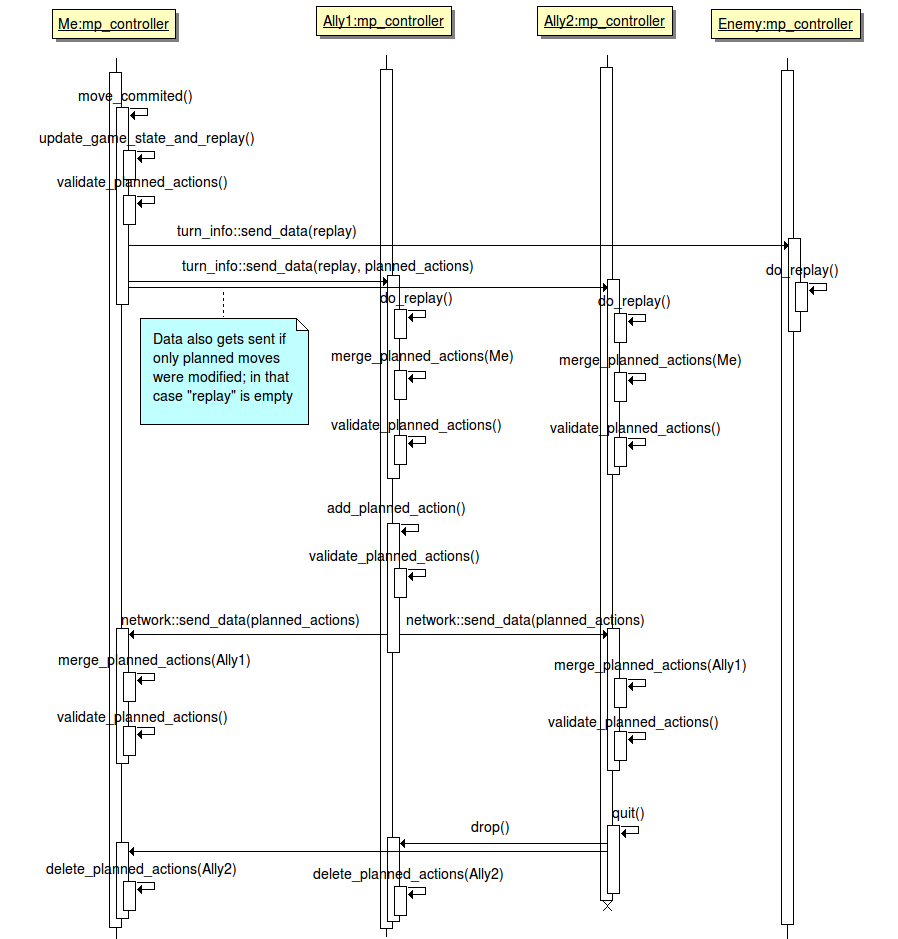
ZOC calculations for planned moves
The "show enemy moves" feature will now be calculated from planned unit positions by default, instead of current unit positions. For this I'll need to build my own unit map and calculate ZOCs from there. When several moves are planned for the same spot, only the last one to be programmed will be taken into account; this will have an influence when ZOC-less and normal units are heading for the same hex.
- Alternatively, we can take into account only the unit with the most powerful ZOC headed for this hex, it might be more intuitive for the player.
Clean up
This is a tentative list of issues resolved, options removed (more KISS) and of areas of the code that will get cleaned up or completely removed as a result of this project.
- "Delay shroud updates" won't be necessary anymore; this will get rid of the "delay shroud update on start" preference, and of the in-game "delay shroud updates" menu element.
- The undo stack and related code will be removed.
- The "sighted" WML event will work properly, now that the conflict with delay shroud updates will be gone.
Gameplay considerations
Recent IRC discussions brought up several possible effects on gameplay that need to be discussed, and I thought of several more:
Removing Gotos
It was argued that removing the current goto system and replacing it with planned actions would be annoying, if players have to confirm the remaining part of planned moves manually on every turn start.
- If you have several planned moves available at the beginning of your turn and they're all trivial moves (i.e. equivalent to gotos), you can just have a quick glance to see if those moves still make sense and then hit "Execute All". The extra keystroke is I think acceptable.
- The only problem I can see with this is if you define some planned moves as reminders of what you'd like to do, and others as gotos. Or, if you have a mix of actions of which some are goto equivalents, and the others really need to be executed one by one. Then executing them all would be annoying.
- A good compromise (suggested by Upthorn if I remember well) would be to execute any remaining planned moves when you end your turn. Is gotos executing at the beginning of the turn an essential feature of Wesnoth? Many strategy games actually execute gotos as you end it, to give you a chance to modify the goto before it's executed.
- Once again with this, keeping some planned moves as reminders from turn to turn to eventually modify them later would not be feasible. However you could plan "draft" moves while it's not your turn, so this option sounds rather reasonable.
- If the above doesn't seem convicing, gotos as they are now can coexist with the planning system. I haven't found any technical issue preventing it. I see it as anti-KISS, but that's a concession I'm ready to make.
Removing Undo
Do we remove the current undo system, or build this new system on top of it?
- Keeping both violates the KISS principle by having two systems side by side that provide rather similar functionality.
- The UI for undo is not user-friendly, since there's no visual cue telling you that you just lost your undo stack, and the reasons why you may lose it only become apparent from experience (for instance recruiting a unit with random traits makes you lose undo, but recruiting undead or recalling units doesn't, as far as I remember).
- The planning system seems better in that aspect, since you get to decide when moves become permanent; the player is more in control and we have a better learning curve.
- The main purpose of undo as I understand it is to allow you to test visually several attack patterns, verifying your ZOC along the way. The planning system provides exactly that, plus:
- The extra benefit of visually planning/canceling recruits: you can visually fill up your castle with future recruits, see how it affects your budget, then change one or two recruits to fine-tune your plan and finally "execute all" to get your recruits.
- Visually planning your attacks and surrounding the enemy, without having to undo a lot of moves to make a small adjustment.
- No danger of losing your planning for reasons such as attacking, ambush, a WML event, or forgetting to set Delay shroud updates.
- The only situation in which the current undo system is more user-friendly than planning is when you do a bunch of undoable moves in a shroud-less game, and you're happy about them and would like to do your attack. The old system just lets you attack, the new one requires you to commit them first. To alleviate this and not force you to commit a bunch of trivial moves one by one, an "Execute All" command that executes all commands without animating them would be ideal. It would stop if one of the moves triggers something that prevents other moves to execute, but for most ordinary moves it would execute all orders instantly.
- All this said, the undo system can also coexist with the planning system, there are no technical issues with this.
Removing Delay Shroud Updates
If we keep undo, do we need to keep Delay Shroud Updates as well, or is the planning system considered a better or at least equal alternative?
- Delay shroud updates is in great part responsible for breaking WML "sighted" events, and is the feature Crab_ and I are the most keen to replace.
- It is also the system for which the planning system is the most direct plug-and-play replacement, as can be read in Removing Undo and Workflow of long-time players.
Default action vs Shift-click action
What should be the default action: setting a planned move, or directly moving the unit (the other being available on shift-click)? And how should the option to toggle the default to the opposite be introduced: preferences option, or menu+hotkey in-game?
- toggle: the best approach seems to be the menu+hotkey (Caps Lock would make a nice hotkey since it's related to shift in the minds of players; not sure if using that key presents technical issues)
- if undos get removed, having permanent moves as the default might be offputting for players used to undoable moves.
Workflow of long-time players
According to noy, the workflow (so to speak) of good players involves making some moves, then an attack, then some more moves depending of the result of that attack. How does this workflow translate into the new system? The following questions/assumptions need answers:
- Do good players use Delay shroud updates? If not, they're not taking advantage of undo capabilities anyways (or very little), and can probably turn off planning mode for the whole game, and happily keep playing as usual.
- When they actually want to visualize several unit placements or recruitments in a zone where they've pushed out the shroud far enough and therefore would currently benefit from undo capabilities, it seems that using shift-click to plan and then instant executing the actions with "Execute all" would not be an additional chore; it would rather be more flexible.
- If they are using delay shroud updates, it seems the planning system would work just as well as the status quo, except with a bit more visual clutter due to arrows:
- Move units around with undo capability = Plan moves
- additional bonus: they get to reorder moves and cancel them without having to backtrack
- Toggle delay shroud updates if you want to take a look at the situation before proceeding = "execute all" or "execute moves one by one"
- additional bonus: if a (rare) special event triggers because of one of the moves, the game won't execute the remaining ones, and you'll be able to ajust your plan in consequence
- Move units around with undo capability = Plan moves
- Do good players use the "Interrupt moves when an ally is sighted" option? This option does absolutely nothing if you leave "delay shroud updates" activated the whole game; however we have to think how to integrate this option in the whole planning framework, since if you're using "execute all" to quickly commit a series of moves without care for enemy sightings, being interrupted constantly by those would be the pinnacle of annoyance.
"Execute All" vs "enable scroll tracking of unit actions"
There's a potential interface conflict between planning actions while it's not your turn, and the "enable scroll tracking of unit actions" preference.
- The most obvious answer to this is to disable scroll tracking when planning mode is activated, otherwise the screen will scroll under your mouse just as you try to set a move.
- As a side note, scroll tracking also makes the view follow your own units that are executing automated gotos.
- But do we need a visual notification for when you're happily planning moves and something is happening outside of your screen? For combat at least, the combat sounds are probably sufficient notifications.
Optional/Future developments
- Allow allies of player A to suggest moves to him while he's playing his turn. Overall idea is: player B moves one of A's units that he sees on screen, creating a planned moves. A then either immediately sees the suggested move (could be a pale line of the suggesting player's color, or something of the sort), or gets a prompt "suggested moves from player B are available", and he can then see a list of suggested moves, see what would their result on-screen be, and choose for each one to apply it (add them to his set of planned actions) or delete it.
- Allow suggesting moves to an allied AI.
- Add a way to show the attack choice and stats for already planned attacks, and to change the weapon used for that attack. Possibly show at the same time all attacks that are going to be executed on a single unit.
- Add drag and drop of planned moves' unit ghosts, for quickly redefining the destination, attack location (another hex around the same target unit) or recruit location.
- Might be useful (if not too hard to use), to allow to make assumptions about enemy units. e.g., "what will zoc look like if those three enemy units are dead ?"
- visual is easy to find: mark them with a a large skull-and-bones similar to pirate flags :)
- auto-assume that units, say, with >80% ctk will be dead ???
- (Very Difficult) Find some way of displaying the dialogues the current player sees to his allies (for instance the item choice screens from Bob's RPG era), but in a non-interactive way, so they can counsel him and be a bit more active when it's not their turn.
Calendar
Note: tasks marked [low-priority] will only be implemented if I'm ahead of schedule when I get to the week they're listed for, or if they are low-hanging fruit after all. Otherwise I'll postpone them to the end of the project, where I'll do them if there's time remaining.
Start of GSoC: May 24
Before mid-term eval
(8 weeks of work) Implement planned moves as a local (non-networked) feature.
- Initial backend work (2 weeks)
- Design and implement planned_move class and the management of its container, vector or otherwise
- Implement operations in planned_move to add, remove planned moves; add stubs for more advanced features such as switching places between moves
- Implement the merge algorithm for planned_action vectors
- Interface for adding and removing planned moves (2 weeks)
- Preliminary display and highlighting of arrows; includes setting up the new graphics layer that will serve for all interface elements
- Preliminary interface to define and delete move arrows
- Add preliminary numbering display and reordering moves
- Implement display of planned attacks, with unit ghosts [low-priority]
- Add "ghosted unit + visual cue" display of planned recruits [low-priority]
- Introduce committing of actions and basic action validation (1 week)
- Implement "commit-on-hover/select" and "commit next", and deleting the planned action
- Implement committing of planned moves
- Implement committing of planned attacks [low-priority]
- Implement committing of recruits [low-priority]
- Implement basic conflict checking (i.e. impossible moves) and preliminary visual warning.
- Now that interface elements won't change much, start recruiting artist contributors in the wesnoth forums so they can help make this thing look better
- Implement "soft conflicts" detection and ZOC display (1 week)
- Add detection and display of multiple moves (includes attack+move [low-priority]) of the current player headed for the same hex
- Implement detection and display of conflicts for all actions planned for the same hex
- Add ZOC (ctrl+v) calculations and display according to planned moves (1 week)
- Remove remaining obsolete code and refactor a bit (1 week)
- Remove undo code if appropriate
- Remove delay shroud updates code if appropriate
- Test if "sighted" wml events now work properly
- Polish interface as much as possible for mid-term eval (remaining time, if any)
Milestone: July 16, Mid-term eval: we have a functional (if ugly) reworked interface and local planning system.
After mid-term eval
(3 weeks of work)
Bugfix and improve the interface (3 weeks)
- Act on feedback received up to now, and get this tested as widely as possible
- If technically possible, bring in players to test too: linux players can probably build from svn, windows players would need a patch against a specific development version.
- Failing that, post videos of the new interface and its progress on YouTube and link to it from the forums, so people can discuss it.
- Make sure all commands are accessible through both menus and shortcut keys.
- Integrate new graphics if we managed to recruit artists
Add the networked part of the whole deal [low-priority]
- Set up and test transmission and merging of planned_action vector diffs between clients (leftover time, est. needed: 2 weeks)
- Implement structure allowing each client to keep a copy of the planned action vector of every other ally in play
- Implement and test continuous syncing mechanism of planned_moves between X number of allies
- Implement interface elements for networked planning system (leftover time, est. needed: 1 week)
- Implement team-colored display according to planned move origin
- Expand soft conflict detection to include planned_actions received from allies
- Add filter backend and dialogs to choose who you share your planned_moves to and who you receive them form
Milestone: August 9, suggested pencils down date: we have a polished reworked interface and planning system. If things went exceptionally well, we also have a multiplayer allied planning system.
Final touches
(1 week of work) Document more, write small after-action report
Milestone: End of GSoC 2010